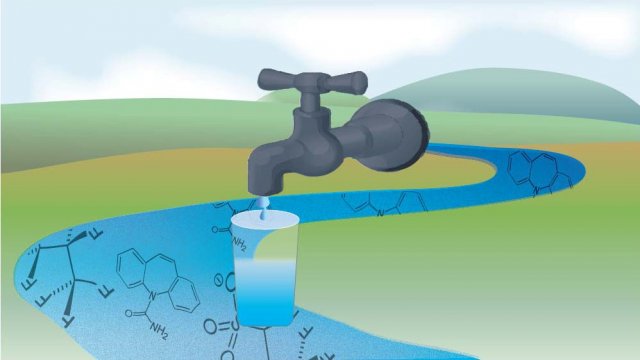Determining the Prevalence of Contaminants in Treated and Untreated Drinking Water

Just 2.5 percent of the Earth’s water is fresh, making it crucial for humans to use water in smart, effective ways that preserve this precious resource. Water reuse has become an important part of the solution. In the United States, wastewater is treated and may then be discharged into surface water or ground water aquifers. There, natural processes including volatilization, dilution, sedimentation, and reactions to sunlight may decrease the concentration of contaminants before the water is taken up for further treatment in drinking water facilities.
Although wastewater and drinking water treatment is designed to remove pollutants, there is potential for trace levels of unregulated contaminants to be present in treated drinking water. Improvements in analytical instrumentation now allow scientists to measure these very low concentrations. There is an emerging awareness of the potential for these chemicals to be present in every portion of the water cycle—wastewater, surface water, groundwater, and drinking water. To develop strategies for protecting human health, EPA needs to understand the prevalence of contaminants in both treated drinking water and its source water.
Scientists from EPA and the U.S. Geological Survey (USGS) conducted a multi-phase study to determine the presence of contaminants of emerging concern (CECs) in treated and untreated drinking water collected from approximately 25 drinking water treatment plants (DWTPs) across the United States. Samples were analyzed for 247 chemical and microbiological pollutants, including a wide range of chemicals used in homes, businesses, and industries. Treatment plants chosen for this study receive waters impacted by a variety of waste sources, including municipal waste, septic systems, and livestock production.
The contaminants examined in the study are not regulated in drinking water by EPA, and little is known about their prevalence. The samples were analyzed by 15 methods for chemicals, microorganisms, and estrogen bioactivity. Analyte selection was focused on pharmaceuticals, but also included other classes of analytes, including per- and polyfluoroalkyl substances (PFAS), hormones, fungi, bacteria, protozoa and viruses.
The studies provide important baseline information on the presence of contaminants in treated and untreated drinking water, as well as qualitative information on the efficacy of differing drinking water treatment technologies in removing contaminants. The results will be used to inform the next generation of EPA drinking water safety standards.
Recent Publications
- PFAS in source and treated drinking waters of the U.S. (2018). This study measured 17 PFAS in source and treated water from 25 DWTPs as part of a broader study of CECs in drinking water across the Nation.
- An introduction to joint research by the USEPA and USGS on CECs in source and treated drinking waters of the U.S. (2017). Introduction to a series of papers that provide important baseline information on the concentrations of CECs from principal source-water types (e.g. surface water, groundwater). Sampling sites were located across a range of hydrologic, climatic, and demographic conditions and were treated using a variety of drinking-water treatment practices.
- Nationwide reconnaissance of CECs in source and treated drinking waters of the U.S. (2017). Source and treated drinking water samples from 29 DWTPs were analyzed as part of a two-phase study to determine whether chemical and microbial constituents, many of which are considered contaminants of emerging concern, were detectable in the waters.
- Nationwide reconnaissance of CECs in source and treated drinking waters of the U.S.: Pharmaceuticals (2017). A joint, two-phase USGS/EPA study that examined source and treated waters from 25 DWTPs to assess the prevalence of pharmaceuticals in such source waters, and to identify which pharmaceuticals persist through drinking water treatment.
- The importance of quality control in validating concentration of CECs in source and treated drinking water samples (2017). A national-scale survey of 247 CECs, including organic and inorganic chemical compounds, and microbial contaminants, was conducted in source and treated drinking water samples from 25 DWTPs. Multiple methods were used to determine these CECs, including six analytical methods to measure 174 pharmaceuticals, personal care products, and pesticides.
- Estimating virus occurrence using Bayesian modeling in multiple drinking water systems of the U.S. (2018). Water samples were concentrated from 25 DWTPs to study the occurrence of enteric viruses in source water and removal after treatment. The five different types of viruses studied were adenovirus, norovirus GI, norovirus GII, enterovirus, and polyomavirus. Quantitative PCR (qPCR) was performed on all samples to determine presence or absence of these viruses in each sample.
- Microbial pathogens in source and treated waters from drinking water treatment plants in the U.S. and implications for human health (2016). An occurrence survey was conducted on selected pathogens in source and treated drinking water collected from 25 DWTPs. Water samples were analyzed for the protozoa Giardia and Cryptosporidium (EPA Method 1623); the fungi Aspergillus fumigatus, Aspergillus niger and Aspergillus terreus (qPCR); and the bacteria Legionella pneumophila (qPCR), Mycobacterium avium, M. avium paratuberculosis, and Mycobacterium intracellulare (qPCR and culture).
- Comparison of in vitro estrogenic activity and estrogen concentrations in source and treated waters from 25 U.S. drinking water treatment plants (2017). Extracts of source and treated drinking water samples were assayed for estrogenic activity using T47D-KBluc cells and analyzed by LC-MS/MS for natural and synthetic estrogens (including estrone, 17B-estradiol, estriol, and ethinyl estradiol).
- Human health screening and public health significance of CECs detected in public water supplies (2017). Source water and treated drinking water from 25 DWTPs were sampled and analyzed for 247 contaminants using 15 chemical and microbiological methods. Most of these contaminants are not regulated currently either in drinking water or in discharges to ambient water by EPA or other U.S. regulatory agencies.
- Aquatic concentrations of chemical analytes compared to ecotoxicity estimates (2017). Provides screening level estimates of potential aquatic toxicity posed by 227 chemical analytes that were measured in 25 ambient water samples collected as part of a joint USGS/EPA DWTP study.
